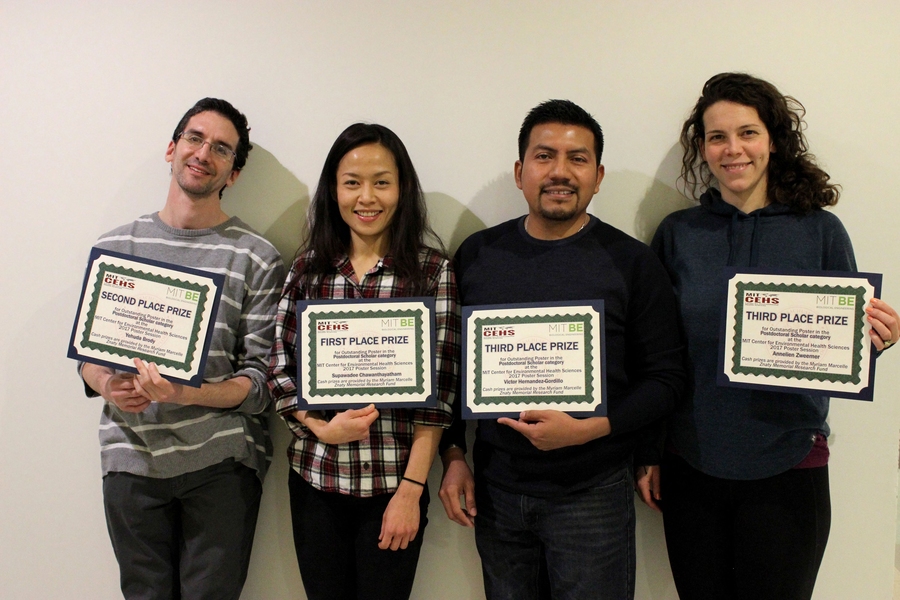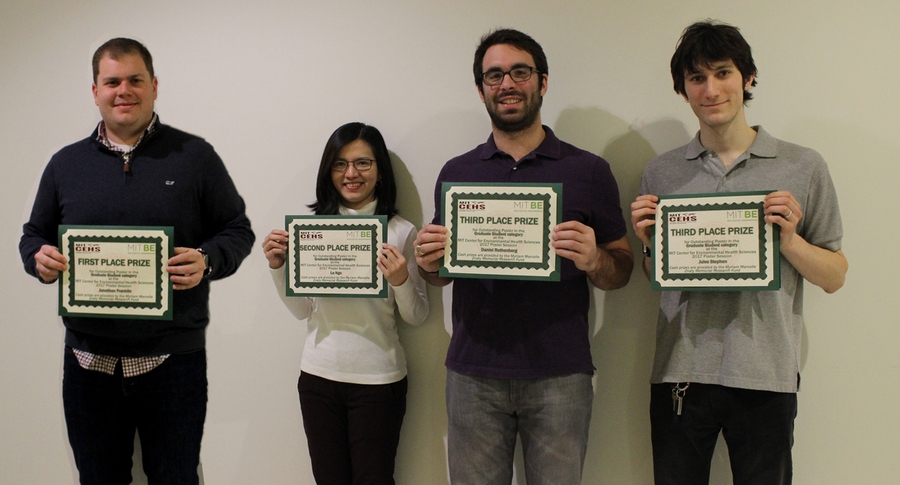The Center for Environmental Health Sciences (CEHS) at MIT held its annual poster session on Jan. 18 in the Building 13 Lobby. The session highlighted the work of the environmental health research communities of MIT and some of the Institute's sister institutions. Over 60 posters were presented from the science and engineering laboratories affiliated with the center.
The CEHS has an overall mission to study the biological effects of exposure to environmental agents in order to understand, and predict, how such exposures affect human health. Moreover, by uncovering the chemical, biochemical and genetic bases for environmental disease, sometimes researchers are able to leverage that understanding to delay or even prevent the development of disease in human populations. To that end, the center brings together 39 MIT faculty members from a total of 10 MIT departments (in both the School of Science and the School of Engineering) plus one Harvard University faculty member from the Harvard School of Public Health.
This year’s CEHS cash prizes are awarded in two categories, graduate students and postdocs. For each category, the prize for first-place is $1,000, second-place prize is $500, and the third-place prize is $200 plus CEHS memorabilia. The cash prizes were made possible by the Myriam Marcelle Znaty Research Fund, which was established over 30 years ago to support the research of young scientists at MIT.
Undergraduate and graduate students, postdocs, and research staff presented the results of their research. Jonathan Franklin from Professor Jesse Kroll’s lab won first place in the graduate student category. Franklin presented his work on the “Measurements of I/SVOC from Mobile Sourcing using online Thermal Desorption EI-MS.” In second place was Le “Lizzie” Ngo from Professor Bevin Engelward’s lab, presenting her work on “Novel Microarray Colony Formation Platform for High-Throughput Viability Testing.” Finally, in a third place tie was Daniel Rothenberg, from Professor Forest White’s lab, presenting his work on “Profiling the Translatome with Bioorthogonal Non-Canonical Amino Acids” and Jules Stephen from the Liz Nolan lab, who presented on “Methionine Oxidation Increases the Protease Sensitivity of Calprotectin by Altering Its Oligomeric State.”
In the postdoc category, first place went to Supawadee “Apple” Chawanthayatham from Professor John Essigmann’s lab, presenting on “Mutational Spectra of Aflatoxin B1 in vivo Establish Biomarkers of Exposure for Human Hepatocellular Carcinoma.” Second place went to Yehuda Brody, from Professor Paul Blainey’s lab, who presented his work on “’Lineage Sequencing’ for Deeper Insights into Exposure-Induced Somatic Mutations.” And lastly, another third place tie went to Victor Hernandez-Gordillo, from Professor Linda Griffith’s lab, after presenting his work on “Toward the Development of an Organotypic Intestinal Model to Recapitulate Epithelial-stromal Interactions,” and Annelien Zweemer from the Douglas Lauffenburger’s lab, who presented her work on “Apoptotic Cell Bodies Elicit Gas6-mediated Migration of AXL-expressing Tumor Cells.”







